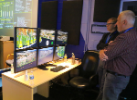School of Engineering and Applied Sciences welcomes collaborators to Motion Simulation Laboratory

By Peter Murphy
Published October 13, 2022
Regional representatives from academia, engineering industries and government agencies discussed possible collaborations and opportunities with the University at Buffalo School of Engineering and Applied Sciences' Motion Simulation Laboratory.
The Motion Simulation Laboratory (MSL) has supported faculty and student researchers at UB for the past 15 years. It is the only simulator of its kind in New York State and has historically been used for research and training activities associated with modeling and simulation related to transportation systems. The University at Buffalo and its School of Engineering and Applied Sciences held this event to engage would-be collaborators, expand existing partnerships, and forecast the MSL’s future capabilities.
“The MSL and its motion simulation capabilities specifically are a critical and integrated component of our broader transportation engineering research/teaching enterprise,” says Kevin Hulme, PhD, program manager for the Stephen Still Institute of Sustainable Transportation and Logistics (ISTL). “We further discussed our plans, to invest and expand MSL’s capabilities to meet current and future requirements of our most likely users and collaborators.”
Past research in the MSL was often funded by organizations like the National Science Foundation (NSF), the National Institutes of Health (NIH), and private companies and contractors, mostly associated with transportation. According to Hulme, this discussion opened the possibility of using the MSL’s capabilities across multiple disciplines.
“Most critically, we discussed the potential for diverse collaborative opportunities upon wide-ranging challenges across disciplinary boundaries, including the transportation safety, medical and clinical and education and training sectors,” Hulme says.
In addition to the current driving simulator in the MSL, the team is developing a hybrid simulator with the potential to significantly expanded the laboratory’s capabilities. The hybrid simulator, paired with the current driving simulator, will allow MSL to have multiple humans driving virtually at the same time. This new simulator will also allow its riders to experience flight simulation and urban air mobility. The hybrid simulator constructs the vehicle cabin virtually rather than physically and allows for more diverse applications in transportation, alongside companion virtual reality (VR) and augmented reality (AR) capabilities.
For more information on the MSL, including current infrastructure, recent projects and publications and contact information, please visit the MSL website, or download the presentation slides from the recent collaborative discussion.











